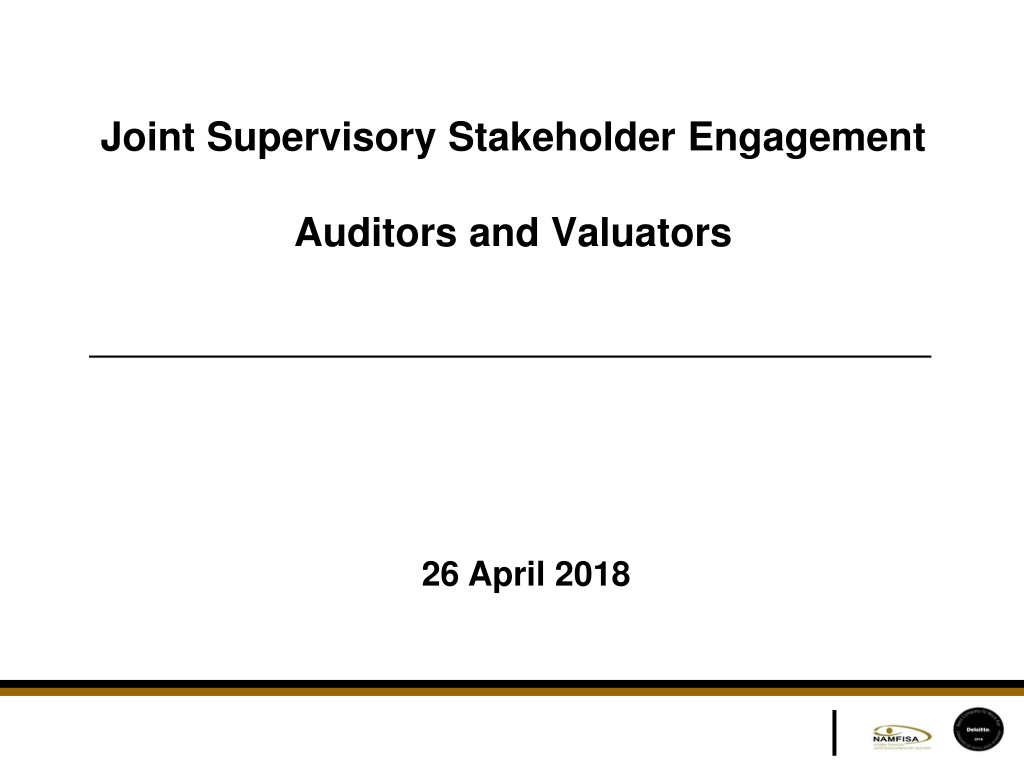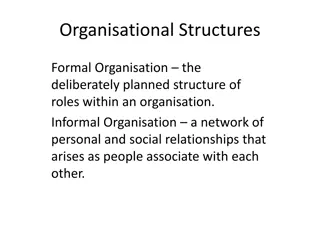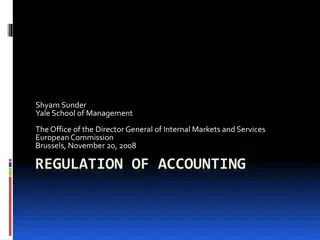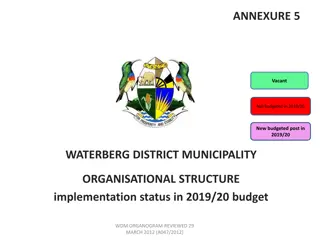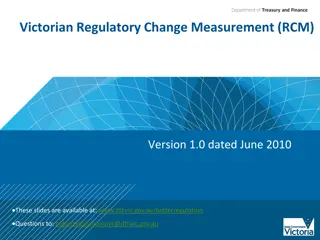NAMFISA Organisational Restructuring and Regulatory Overview
NAMFISA, established under the NAMFISA Act of 2001, exercises supervision over financial institutions and services in Namibia. The organization recently underwent an organizational restructuring to optimize resources and enhance efficiency. They oversee a broad regulatory scope covering various financial sectors and have a significant number of regulated intermediaries and institutions. The team comprises heads of prudential supervision and is focused on ensuring compliance while advising on regulatory matters.
Download Presentation

Please find below an Image/Link to download the presentation.
The content on the website is provided AS IS for your information and personal use only. It may not be sold, licensed, or shared on other websites without obtaining consent from the author. Download presentation by click this link. If you encounter any issues during the download, it is possible that the publisher has removed the file from their server.
E N D
Presentation Transcript
Joint Supervisory Stakeholder Engagement Auditors and Valuators 26 April 2018 |
CONTENT Introduction Regulatory Scope Organisational Restructuring Regulatory Reform Auditors & Valuators under the FIM Supervision and Inspections Conclusion |
Introduction / Establishment NAMFISA was established by an Act of parliament, NAMFISA Act 3 of 2001 with the objective to: Exercise supervision over the business of financial institutions and financial services; Advise the Minister of Finance on matters related to financial institutions and services; Enforce Compliance with Financial Intelligence Act |
TEAM// Prudential Supervision Heads Kenneth Matomola Chief Executive Officer Erna Motinga Deputy CEO: Prudential Supervision Grace Mohamed GM: Insurance & Medical Aid Funds Lovisa Indongo-Namandje GM: Pension Funds & Friendly Societies Floris Fleermuys GM: RPS Evangelina Nailenge GM: Capital Markets |
Current Regulatory ambit / Regulatory Scope Long-term Insurance Micro Lenders (Usury) Short-term Insurance Participation Bonds Medical Aid Funds NAMFISA Stock Exchange Pension Funds Friendly Societies Unit Trusts |
Current Regulatory ambit / Regulatory Scope Size of the Regulated Financial Sector (31 Dec 2017) No. of intermediaries Assets N$ No. of institutions 6464 586 N$ 443.49 billion |
TEAM// Organisational Restructuring NAMFISA embarked on an organisational restructuring exercise in order to Optimise resources; Maximise efficiencies; Enhance focus on our core mandate and Ensure prudent financial management. The new structure groups all prudential supervisory divisions under one stream and has a separate stream for market conduct and operations. Each stream is headed by a Deputy Chief Executive Officer. The new structure became effective on 1 April 2018. |
TEAM// Organisational Restructuring NEW STRUCTURE CEO DCEO: Market Conduct & Operational DCEO: Prudential Supervision GM: Pension Funds & Friendly Societies GM: Insurance & Medical Aid Funds Manager: Corporate Communication GM: Market Conduct GM: Capital Markets GM: Legal Services GM: RPS Head: GRC GM: Finance and Admin GM: ICT GM: HR |
TEAM// MARKET CONDUCT DIVISION GM: Market Conduct Manager: Microlending & Intermediaries Manager: Inspections & AML Manager: Consumer Complaints & Education Manager: Licensing & Registration |
TEAM// LICENSING & REGISTRATION The most significant alteration is the introduction of a Licensing and Registration department. The Licensing and Registration department will be responsible for, amongst others: Registration of Financial Institutions and Intermediaries; Deregistration (Initiated); Deregistration (Voluntary); Approval of appointments of certain Key Persons (i.e. POs, Auditors, Valuators etc.); Name Reservations and Changes, Transfer of Shareholding; and Issuance of Certificates of Good Standing. |
Proposed Legislative reforms //- Bills status Proposed Bill Status Financial Institutions and Markets (FIM ) Bill Supported by subordinate legislation e.g. Regulations and Standards Final draft available on the NAMFISA o Final draft of the FIM Bill submitted to MOF by MOJ during September 2017 website NAMFISA Bill To be sent to the Attorney-General for certification, via the Cabinet and then onwards to National Assembly o Final draft available on the NAMFISA website Financial Services Adjudicator (FSA) Bill Final draft available on the NAMFISA website |
Proposed Legislative reforms //- Bills status Proposed Bill Status Microlending Bill Supported by subordinate legislation e.g. Regulations and Standards Final draft available on the NAMFISA Tabled in Parliament on 22 February 2018 Phase 1 critical Standards (6) and Regulation (1) shared with industry for their comments, finalized and submitted to Ministry of Finance for certification. Phase 2 less critical Penalty Regulation crafted and shared with industry for comments. Comments received from industry being considered. Phase 2 less critical Standards (6) still need to be shared with industry. o o website o o Consumer Credit Bill Necessary research will be conducted in due course for purposes of framing a policy document o Policy document will form the basis of the Consumer Credit Bill o |
Proposed Legislative reforms //- Standards and Regulations Status of Standards and Regulations First Phase Standards and Regulations Informal consultations held with industry during 2015 Submitted to Ministry of Finance for certification. Formal public consultation to commence once FIM is promulgated Second Phase Standards and Regulations Draft Standards were distributed to industry for comment during 2017 Comments from industry were addressed Third Phase Standards and Regulations Drafting is spread over next 3 financial years, having regard to priority of particular Standards and Regulations |
Proposed Legislative reforms / Benefits An integrated approach to supervision and regulation of the NBFIs, in particular uniformity and consistency of rules and provisions, resulting in: Elimination of silos; and Elimination of conflicting provisions and regulatory arbitrage. Minister and NAMFISA to issue Regulations and Standards respectively Provides for greater regulatory responsiveness, i.e. flexibility in adapting standards and regulations |
FIM Bill /Scope of regulation (General provisions) Registration which requires a test for fit and proper of key persons Prohibits operation of unregistered entities Powers to impose conditions for registration Financial institutions to maintain principal office and principal officer in the country Governance issues and Board composition of NBFI s powers to require compliance and adopt sound governance practices |
FIM Bill / Auditors & Valuator REQ (Supervision) Main new supervision provisions include: Appointment of auditors and valuators mandatory for all FI; Required filings audits, valuations (short-term insurers required to submit actuarial reports annually); Power to direct replacement of auditors and valuators (Not FAP and NOT independent); Total independence of Auditors & Valuators FAP requirements set out in Standards Power to require special reports; |
FIM Bill / Auditors & Valuator REQ (Supervision) (cont) Auditors and Valuators afforded full access to accounting and other records and access to Key management; Auditors and Valuators afforded power to access and speak at any Board meeting of the FI; Audit and valuation reports filed within 90 days after end of the Financial period Report on transactions that will significantly and adversely impact the financial position to Board, PO and NAMFISA |
INSPECTIONS -//- Supervisory Ladder of Intervention No. entities of % of total entities Stages Remarks Stage 1 (no significant problems) 62% 361 13% Stage 2 (early warning) 76 Generally all sectors are sound. continues to engage the entities on non-compliance issues. The Pension Funds sector significantly to stage 5 entities Stage 3 (risk to viability or solvency) NAMFISA 7% 43 Stage 4 (future viability in serious doubt) 5% 30 contributes Stage 5 (entity not viable or insolvency imminent) 13% 75 Total 585 100% |
INSPECTIONS / Key Findings- INSURANCE - AFS Insurers IFRS 4 insurance contracts not very prescriptive and no consistency in Financial reporting Difficulty in comparing the AFS of the insurers Deposits under ART business included in Revenue (GWP) Repayments of deposits included in Claims expense Limited disclosures on intercompany balances, Unapproved loans Revenue recognized on a cash basis and no adjustments for UPR No real evidence of insurance liabilities adequacy testing Audits in most cases do NOT require the Regulatory solvency requirements in terms of the ACT, only IFRS based |
INSPECTIONS / Key Findings- INSURANCE - AFS Insurers Insurance liabilities and related RI recoveries shown on a net basis Commission paid to intermediaries NOT found to be within the limits per the Regulations. Material DEBIT revenues recognized due to deposit repayments recorded as renewal premiums Insurance intermediaries Lack of comparability owing to the different forms of ownership structures AFS not filed with the Registrar within the stipulated timeframes |
INSPECTIONS / Key Findings- MAF - AFS Inaccurate qualitative information presented in the AFS Note disclosures often incomplete in the audited AFS Need for inclusion of sensitivity analyses in the pricing review RPT s |
INSPECTIONS / Key Findings - PENSION FUNDS Long serving auditors: Raises familiarity risks to independence and objectivity; Audit Relationships should be reviewed regularly to ensure that the relationship is still independent; The impartiality/objectivity of the auditor must be maintained. Non-adherence to IFRS nor ICAN guidelines in the preparation of financial statements: Resulting in reportable irregularities; Correction of financial statements required; Necessary action taken against the auditors with the relevant regulatory body. |
INSPECTIONS / Key Findings - PENSION FUNDS Valuators: Must be independent of the Fund Long serving valuators Raises familiarity risks to independence and objectivity The impartiality/objectivity of the valuator must be maintained. Valuators Assumptions: Inconsistencies in assumptions made by valuators in actuarial reports e.g. discount rates, demographic characteristics etc. which do not reflect the realities of the fund Valuators recommendations not considered and implemented by the Fund: Information contained in an actuarial report is complex and can be difficult to understand Short and long-term implications for decision makers |
INSPECTIONS / Key Findings UIMs, SPVs, UNIT TRUSTS & INVESTMENT MANAGERS -AFS Insufficient/inadequate disclosures in the notes to the AFS AFS does not include all items as required in the Regulations (Reg. 29(57) Standard Disclosure as required in terms of subsection (1) of Section 10 of the Unit Trusts Control Act not complied with. |
Q & A |
